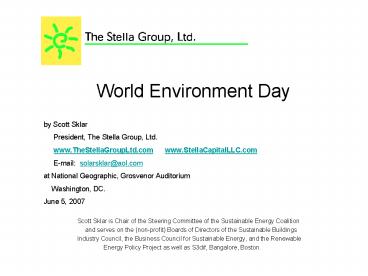World Environment Day - PowerPoint PPT Presentation
1 / 14
Title:
World Environment Day
Description:
Concentrating solar power 63. Photovoltaics 63. Wind 181. Biofuels 58. Biomass 75 ... solar thermal installations exceeds even that of wind power, ... – PowerPoint PPT presentation
Number of Views:11058
Avg rating:3.0/5.0
Title: World Environment Day
1
World Environment Day
- by Scott Sklar
- President, The Stella Group, Ltd.
- www.TheStellaGroupLtd.com
www.StellaCapitalLLC.com - E-mail solarsklar_at_aol.com
- at National Geographic, Grosvenor Auditorium
- Washington, DC.
- June 5, 2007
- Scott Sklar is Chair of the Steering
Committee of the Sustainable Energy Coalition - and serves on the (non-profit) Boards
of Directors of the Sustainable Buildings - Industry Council, the Business Council
for Sustainable Energy, and the Renewable - Energy Policy Project as well as S3dif,
Bangalore, Boston.
2
GHG - SOURCES
Figure 3 Sources of Anthropogenic GHG
Emissions Waste Disposal 02 Residential
Commercial 12 Transportation 14 Agriculture 20
Electric Power 20 Industrial
Processes 32 Sources Distribution to sectors
for CO2, CH4, and N2O is from EDGAR, 2000. All
other GHGs are assumed to be from industrial
processes.
3
Multiple Benefits Local Picture
- Distributed generation - near the users
- Power quality - no surges, sags, transients
- Power reliability - back-up - augmentation
- Dedicated to uniquely high energy rates
- expressed in demand charges, peak
- power and ratchet rates
- Lower noise, emissions, waste streams
4
ENERGY (r)evolution
- January 2007 - Greenpeace/EREC commissioned DLR
(German NASA) - Economically feasible to cut global
- CO2 by 50 within the next 43 years
- Massive utilization of energy efficiency
- Massive uptake in renewable energy in
- all areas - transp, bdgs, gen, indust, ag
- www.greenpeace.org
5
ASES Study (continued) CARBON OFFSET
CONTRIBUTIONS (in MtC/yr in 2030) (based on
middle range of carbon conversions) Energy
efficiency 688 Concentrating solar power
63 Photovoltaics 63
Wind 181
Biofuels 58 Biomass 75 Geothermal 83
6
Tackling Climate Change in US
- NREL papers commissioned by ASES
- and the Sierra Club released in Feb 2007
- Ability to achieve emission cuts between
- 60 - 80 of current levels thru energy
- efficiency and renewable energy options
- Two scenarios thru 2030 and 2050
- www.ases.org
- - continued -
7
U.S. Renewable Electricity Generation in 2030
Can provide baseload or near-baseload power
8
U.S. Carbon Emissions Displacement Potential from
Energy Efficiency and Renewable Energy by 2030
57 Energy Efficiency, 43 Renewables
9
(No Transcript)
10
"All companies have a duty to provide
shareholders with more analysis and disclosure
on climate risks and their strategies for
managing or mitigating those risks," said Dr.
Julie Fox Gorte, vice president and chief social
investment strategist at Calvert.
11
IEA GLOBALSOLAR WATER HEATING
- 10 November 2004. The International Energy
Agencys Solar Heating and Cooling Programme and
major solar thermal trade associations publish
new statistics on the use of solar thermal
energy. The new data expressed for the first
time in GWth, rather than in square meters of
installed collector area shows the global
installed capacity to be 70 GWth (70.000 MWth). - "Now the solar thermal capacity should show up in
all statistics alongside the capacities of other
renewable energies", says ESTIF President Ole
Pilgaard. "And seeing that the world wide
capacity of solar thermal installations exceeds
even that of wind power, people will realise that
our technology can contribute tremendously to
reducing greenhouse gas emissions and to making
the global energy supply more sustainable."
12
Biomass - BioFuels
- Fort Collins, Colorado RenewableEnergyAccess.com
2007-04-11 Researchers at Colorado State
University and the U.S. Department of
Agriculture, Agricultural Research Service have
completed an analysis of greenhouse gas emissions
from biofuel production. Study results revealed
that when compared with the life cycle of
gasoline and diesel, ethanol and biodiesel from
corn and soybean rotations reduced greenhouse gas
emission by nearly 40 percent, reed canarygrass
by 85 percent, and switchgrass and hybrid poplar
by 115 percent. - Hybrid poplar and switchgrass were found to
offset the largest amounts of fossil fuels and
therefore reduced emissions the most out of the
studied crops. - Researchers were able to use life cycle analyses
and the DAYCENT model to account for all of these
factors as well as integrate climate, soil
properties and land use to accurately evaluate
the impact of bioenergy cropping systems on crop
production, soil organic carbon and greenhouse
gas fluxes. The study was published in the April
2007 issue of Ecological Applications. For
Further Information National Renewable Energy
Laboratory (NREL) www.nrel.gov
13
PEW CLIMATE STUDY US 2006
- Pew Center Study Addresses Global Climate Change
- Washington, DC RenewableEnergyAccess.com
2006-02-22 In a report from the Pew Center on
Global Climate Change, a culmination of a
two-year effort that articulates a pragmatic
course of action across all areas of the economy,
is the first comprehensive plan to reduce
greenhouse gas emissions in the U.S. - NOTE
The report concludes that there is no single
technology fix, no single policy instrument, and
no single sector that can solve this problem on
its own. Rather, a combination of technology
investment and market development
Among the many recommendations, in connection
with area of energy and electricity, is a call
"Incentives and a nationwide platform to track
and trade renewable energy credits are
recommended to support increased renewable
power."
14
Conclusions
- Energy efficiency can negate emissions growth
- Renewables can provide significant deep cuts in
emissions - The world is blessed with abundant renewable
resources spread throughout the globe - with
decentralized applications having the greatest
near term - impact and larger, centralized applications
having longer term benefits - Renewables can provide 1/2 of global energy
remaining split about evenly among the renewable
resources - EE and RE can begin today to tackle global
warming - Continued RD and policy support will help these
technologies achieve their large future
potential, tied to aggressive tax and tariff
policies































